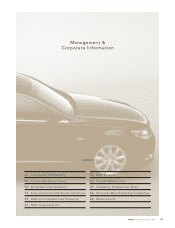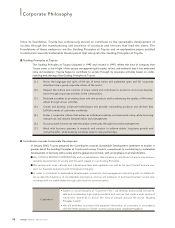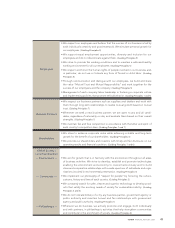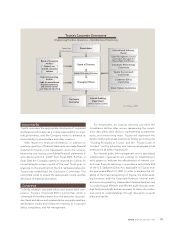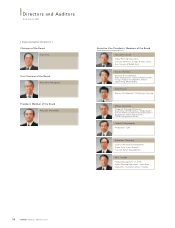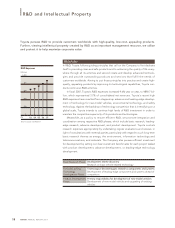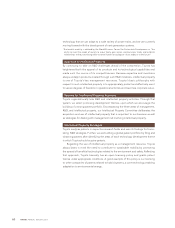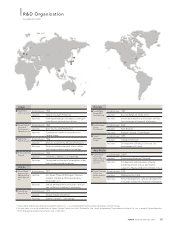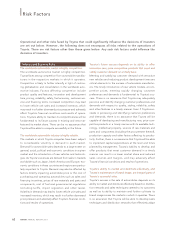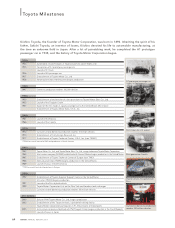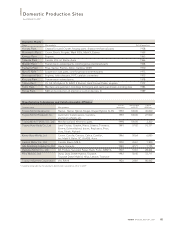Toyota 2007 Annual Report Download - page 58
Download and view the complete annual report
Please find page 58 of the 2007 Toyota annual report below. You can navigate through the pages in the report by either clicking on the pages listed below, or by using the keyword search tool below to find specific information within the annual report.
56 ANNUAL REPORT 2007
Environmental and Social Initiatives
[ Environmental ]
Energy / Global Warming
Toyota is taking a comprehensive approach to energy and global warming issues
by promoting measures to reduce CO2emissions, in both the development and
design stages as well as during production and logistics, while also taking action
to improve traffic flows and promote reforestation.
•Cumulative sales of hybrid vehicles top one million units.
(as of the end of May 2007)
•The goal to reduce CO2emissions from fixed emission sources was achieved.
•The CO2emissions reduction goal in the area of logistics was achieved by
implementing measures, such as a shift to a mode of transport with low CO2
emissions per unit and a reduction in the total distance traveled.
Recycling of Resources
In order to improve resource productivity, Toyota is promoting the effective
utilization of resources, reducing water consumption, and encouraging the
development of designs for recycling.
•Reduction goals were set for the volume of waste not processed within Toyota.
•In response to automobile recycling laws in Japan and overseas, Toyota
steadily implemented measures to properly collect, recycle / recover, and
treat airbags, ASR*, and CFCs / HFCs**.
•To further enhance ASR recycling / recovery technologies, Toyota began
verification testing of technologies to separate resins from ASR.
**ASR: Automobile Shredder Residue
** CFCs / HFCs: fluorocarbon
Substances of Concern
Toyota is managing substances of concern in its companywide system, under a
basic policy of implementing thorough measures to totally eliminate substances
of concern from all vehicles, and is taking actions globally, in the areas of both
products and production.
•Toyota launched the LS460 and Corolla, which contain absolutely no
substances of concern.
•The goal to reduce the discharge volume of substances subject to PRTR* was
achieved.
*PRTR: Pollutant Release and Transfer Register
Atmospheric Quality
Toyota has specified the reduction of exhaust and VOC* emissions as action items
and, in the area of products, is developing low emissions technologies and
introducing low emission vehicles according to the local conditions in various
countries. In the area of production, Toyota is promoting the introduction of
water-borne paints.
•The number of vehicles that meet or surpass the Ultra Low-Emission Vehicle
level (50% or 75% lower than the 2005 Exhaust Emissions Standards) reached
97.7% of total production.
•Toyota introduced water-borne paints in body painting lines of all plants.
Average VOC emissions on all vehicle body painting lines were reduced
to 27g / m2.
*VOC: Volatile Organic Compound
Environmental Management
In the first year of implementation of the Fourth Toyota Environmental Action
Plan, Toyota began steady action in line with the plan.
•The China Environment Committee was established in March 2007 to create a
five-committee structure worldwide.
•Eco-Factory activities were conducted on an ongoing basis.
•The first Global Environment Awards were presented.
’07
1,000
(May end)(December end)
Cumulative Hybrid Vehicle Sales (Worldwide)
(Thousands of units)
1,000
800
600
400
200
0
’97 ’98 ’99 ’00 ’01 ’02 ’03 ’04 ’05 ’06
Results Results
(FY 2007 results)
* Japan Automobile Recycling Promotion Center
Number of vehicles
collected for ASR
Number of vehicles collected
for airbag recovery
Number of vehicles collected
for CFC / HFC recovery
Recycling /
recovery rate
957,000 Funds paid from
JARC*
Expense for
recycling / recovery
and treatment
186,000
713,000
ASR
Airbags
66%
94%
¥8,092
million
¥8,434
million
–¥342
million
Balance
Recycling / Recovery of the Three Specified Items
’07
Low Emission Vehicles as a Percentage of Total Production
(%)
100
80
60
40
20
0
’03
25% lower than
standard levels
for 2000
50% lower than
standard levels
for 2000
75% lower than
standard levels
for 2000
50% lower than
standard levels
for 2005
75% lower than
standard levels
for 2005
’04 ’05 ’06
FY
Note: Fiscal years ended March 31
Promotion Structure for Global Environmental Management
(2004~)
European Environment
Committee
China Environment
Committee
Toyota Environment
Committee
North American
Environment Committee
South American
Environment Committee
(2006~)
(1992~)
(2003~)
(2007~)
Corolla AXIO



